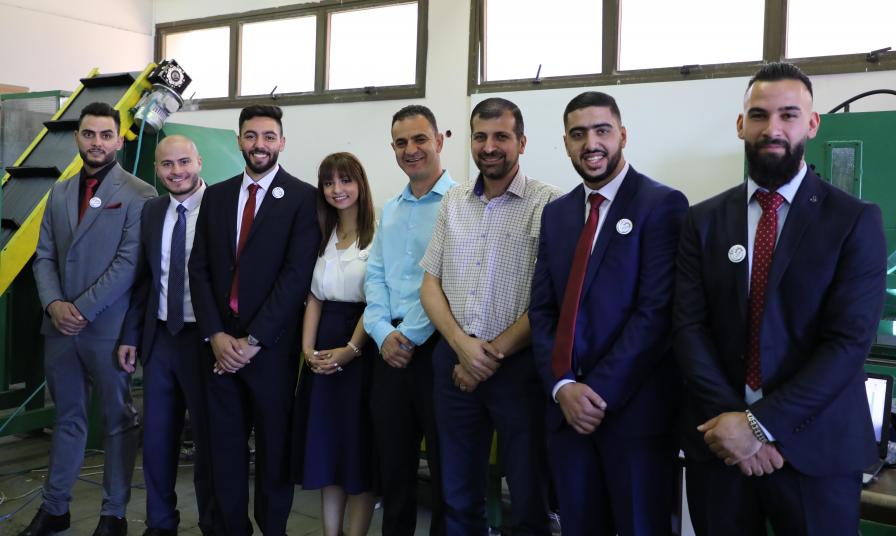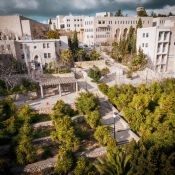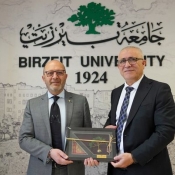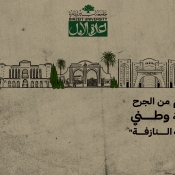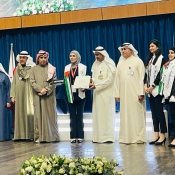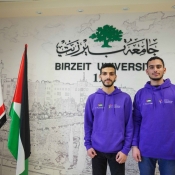Modern technology meets traditional agriculture: The Automatic Tray Seeding Machine
In front of more than a hundred of his family members, classmates, and professors, Yousef Al Shayeb joined his six team members in explaining, in great detail, how the Automatic Tray Seeding Machine, their capstone project, works. His presentation, however, was recorded in an Israeli prison and played to the attending audience in the Engineering Workshops at Birzeit University.
The team of engineering students – Tariq Shawahni, Osama Al-Baransi, Rand Musaffer, Malik Nawabeet, Mohammad Kawazbi, Ameen Allan, and Yousef Al Shayeb – designed and built a 10-meter machine that mixes soil with perlite to produce potting mix, fills it into pre-fabricated seed trays, inserts the seeds, and packages the trays neatly for shipping – all done automatically with the push of a button.
“Even I was surprised when I heard Yousef’s [Al Shayeb] voice. It really took us all by surprise,” said Dr. Sameh Abu Awad, chair of the Department of Mechanical and Mechatronics Engineering and the team’s capstone project supervisor. “Not only is such a project unheard of in Palestinian universities, but the team was able to overcome many challenges and hurdles along the way using nothing but their ingenuity,” he added.
Trials and tribulations
“We were faced with many technical and financial challenges during the design and implementation stages of the project,” observed Shawahni. “But we were able to work around them with what we had. What really helped us was the support of the professors, engineering teaching assistants, workshop assistants, and some of our suppliers – Professor Sameh Abu Awad even gave us money from his own pocket to continue with the project.”
The scale of the project, however, explains the issues that the team faced. The machine is electronically monitored, with control systems sourcing data from sensors to determine the precise ratio of soil to perlite; the ideal amount of potting mix in each insert of the seed trays; and a user-configurable number of seeds per each mix-filled insert.
“We created a machine that rivaled $100,000 Italian tray seeding machines out of parts that were available locally,” commented Shawahni. “Because of the shortage of materials, we had to improvise. For example, we fabricated the vacuum that takes the seeds from the container and deposits them in the seed trays ourselves. We precisely machined the outer layer out of aluminum and the inner layer out of plastic in such a fashion that the space between them is measured in micrometers.”
Every single part of the machine, apart from the servomotors and the programming of the control systems, was created and installed by the team. This included the blades that mix the soil, which were actually steel rods that the team bent into shape; the pressing rolls, fabricated out of plastic by the team, instead of using the more expensive 3D-printed alternative; and the conveyor belt that kept snapping the steel rods used to install it into place.
Financing a bright idea
“It is an innovative idea that really caught our attention when they first submitted their proposal for funding under the Creative Cluster Campus Project,” said Mustafa Ali, the Palestine Techno Park’s administrator and accountant. After reviewing their proposal, the park funded the team’s project with $20,000.
“The project is sustainable and has the potential to help the Palestinian agricultural sector immensely by innovatively integrating information technology into agricultural production,” noted Ali. “It will economically enable many farmers in an otherwise largely impoverished sector.”
The Palestine Techno Park also provided the team with technical and business skills training, such as inviting a representative from the CARE, an international humanitarian relief organization, to review the project, suggest improvements, and possibly secure future funding.
Additionally, the park solicited the advice and feedback of a number of consultants from the Palestinian market to give the team a better view of the needs and wants of consumers, particularly individual Palestinian farmers.
“The machine has the ability to produce 508 seed trays per hour, and this ratio can be fine-tuned by the customer. This will allow the farmers to cut costs on labor, while also freeing them to take care of other, more important aspects of agriculture,” remarked Allan, who emphasized that the machine is designed with the Palestinian agricultural sector in mind.
Preparing for the future
“It would be a shame if such a bright idea, and an amazing execution, were to go to waste,” mentioned Abu Awad. “We’re currently soliciting offers from many consumers from Palestine and the neighboring countries.”
Even before finalizing the machine, the team was receiving offers from Palestinian and international customers. In November of 2017, the team took part in the European Speak Out for Engineering competition, held in Seville, Spain.
Despite going up against projects derived from Ph.D. dissertations, the team’s project ranked third overall in the competition and, more importantly, gained international recognition for their efforts.
“We’re planning to further refine the machine based on feedback from pilot programs in Palestine,” said Allan. “The machine has been designed to be both modular and customizable, such that if a farmer needs one segment of the machine, say, the vacuum seed dispenser, he could order it as a standalone part.”
The team members are considering a number of options for producing and marketing the machine. One option could be leasing, which would allow a farmer to lease the machine for a pre-defined amount of time. The team also mentioned another option, to create a full production line of machines. That, noted Allan, could be expanded to include the Middle Eastern and North African markets.

